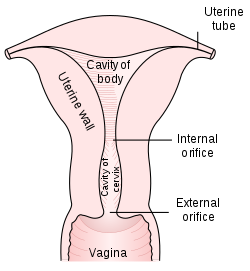Uterus

The uterus, commonly referred to as the womb, is a pivotal component of the reproductive system in the female body. It serves as the nurturing ground where a fetus develops over the course of roughly nine months during pregnancy. Shaped reminiscently of a pear, this organ is strategically situated posterior to the bladder and anterior to the rectum. In non-pregnant conditions, the uterus weighs around 70 grams. A distinctive feature of the uterus is the endometrium, which is periodically shed resulting in the menstrual flow (menstruation) in cyclic intervals, averaging 28 days for most women, though this duration can vary individually. Upon fertilization, an egg migrates via the fallopian tube and finds its anchoring spot in the endometrium.
Anatomy[edit]
Positioned as a core structure within the female reproductive system, the uterus has its existence complemented by the vagina, ovaries, and fallopian tubes. Breaking down its anatomy, the uterus is demarcated into four main regions:
- The fundus, which forms the rounded top.
- The central body of the uterus.
- The uterotubal angles that seamlessly connect to the fallopian tubes.
- And the base, known as the cervix.
In terms of layering:
The outermost layer is named the perimetrium or alternatively, the serosa.<ref>Another name for the perimetrium is serosa.</ref> This slender lining encapsulates the uterus and primarily consists of epithelial cell tissue. The robust middle layer, myometrium, constitutes the bulk of the uterine structure. blood vessels play a pivotal role in supplying nutrients to the uterus. While arteries like the internal iliac, ovarian, and uterine arteries ensure a steady flow of blood to the uterine layers, veins are responsible for the return journey to the heart and lungs.
An intricate ligamentary system, including the anterior, posterior, lateral, uterosacral, and round ligaments, holds the uterus securely in position. Notably, the relative positioning of the uterus can fluctuate depending on the bladder's content.
Throughout a woman's lifespan, the uterus undergoes various phases. From dormancy during childhood and senescence, to heightened activity during reproductive years, the uterus is integral for menstruation, fetal development, and childbirth.
Tumors[edit]
Though infrequent, the uterus can be susceptible to cancers, the prominent ones being endometrial cancer and uterine sarcoma. While endometrial cancer arises from the endometrial lining cells, uterine sarcoma, albeit rare, originates from the smooth muscle cells.
Abnormal uterus[edit]

Congenital abnormalities can sometimes result in an atypical uterine structure. Such conditions might be accompanied by anomalies in other organs too.
Pregnancy[edit]
With the onset of pregnancy, the uterus undergoes dramatic transformations. From accommodating the growing fetus to housing the placenta and amniotic fluid, its volume can expand to hold five to twenty liters. Predominantly, the uterus comprises smooth muscle, the myometrium, which exhibits cellular proliferation during pregnancy. As pregnancy advances, the outer myometrium thickens, while the inner layer becomes comparably thinner, allowing healthcare practitioners to palpate the fetus.
Uterine prolapse[edit]
In certain situations, the uterus can descend, becoming visible through the vagina. This phenomenon, more prevalent in older women, can be attributed to:
- Aging
- Diminished estrogen post-menopause
- Obesity
- Chronic coughing
- Tumors
- Excessive strain during bowel movements
- Weakened pelvic muscles
See Also[edit]
Menstruation Pregnancy Human reproductive system
References[edit]
<references />
References[edit]
<references group="" responsive="1"></references>
|
|
|
| Female reproductive system | ||||||||||||||||||||
|---|---|---|---|---|---|---|---|---|---|---|---|---|---|---|---|---|---|---|---|---|
|
Ad. Transform your life with W8MD's Budget GLP-1 injections from $75


W8MD offers a medical weight loss program to lose weight in Philadelphia. Our physician-supervised medical weight loss provides:
- Weight loss injections in NYC (generic and brand names):
- Zepbound / Mounjaro, Wegovy / Ozempic, Saxenda
- Most insurances accepted or discounted self-pay rates. We will obtain insurance prior authorizations if needed.
- Generic GLP1 weight loss injections from $75 for the starting dose.
- Also offer prescription weight loss medications including Phentermine, Qsymia, Diethylpropion, Contrave etc.
NYC weight loss doctor appointmentsNYC weight loss doctor appointments
Start your NYC weight loss journey today at our NYC medical weight loss and Philadelphia medical weight loss clinics.
- Call 718-946-5500 to lose weight in NYC or for medical weight loss in Philadelphia 215-676-2334.
- Tags:NYC medical weight loss, Philadelphia lose weight Zepbound NYC, Budget GLP1 weight loss injections, Wegovy Philadelphia, Wegovy NYC, Philadelphia medical weight loss, Brookly weight loss and Wegovy NYC
|
WikiMD's Wellness Encyclopedia |
| Let Food Be Thy Medicine Medicine Thy Food - Hippocrates |
Medical Disclaimer: WikiMD is not a substitute for professional medical advice. The information on WikiMD is provided as an information resource only, may be incorrect, outdated or misleading, and is not to be used or relied on for any diagnostic or treatment purposes. Please consult your health care provider before making any healthcare decisions or for guidance about a specific medical condition. WikiMD expressly disclaims responsibility, and shall have no liability, for any damages, loss, injury, or liability whatsoever suffered as a result of your reliance on the information contained in this site. By visiting this site you agree to the foregoing terms and conditions, which may from time to time be changed or supplemented by WikiMD. If you do not agree to the foregoing terms and conditions, you should not enter or use this site. See full disclaimer.
Credits:Most images are courtesy of Wikimedia commons, and templates, categories Wikipedia, licensed under CC BY SA or similar.
Translate this page: - East Asian
中文,
日本,
한국어,
South Asian
हिन्दी,
தமிழ்,
తెలుగు,
Urdu,
ಕನ್ನಡ,
Southeast Asian
Indonesian,
Vietnamese,
Thai,
မြန်မာဘာသာ,
বাংলা
European
español,
Deutsch,
français,
Greek,
português do Brasil,
polski,
română,
русский,
Nederlands,
norsk,
svenska,
suomi,
Italian
Middle Eastern & African
عربى,
Turkish,
Persian,
Hebrew,
Afrikaans,
isiZulu,
Kiswahili,
Other
Bulgarian,
Hungarian,
Czech,
Swedish,
മലയാളം,
मराठी,
ਪੰਜਾਬੀ,
ગુજરાતી,
Portuguese,
Ukrainian


